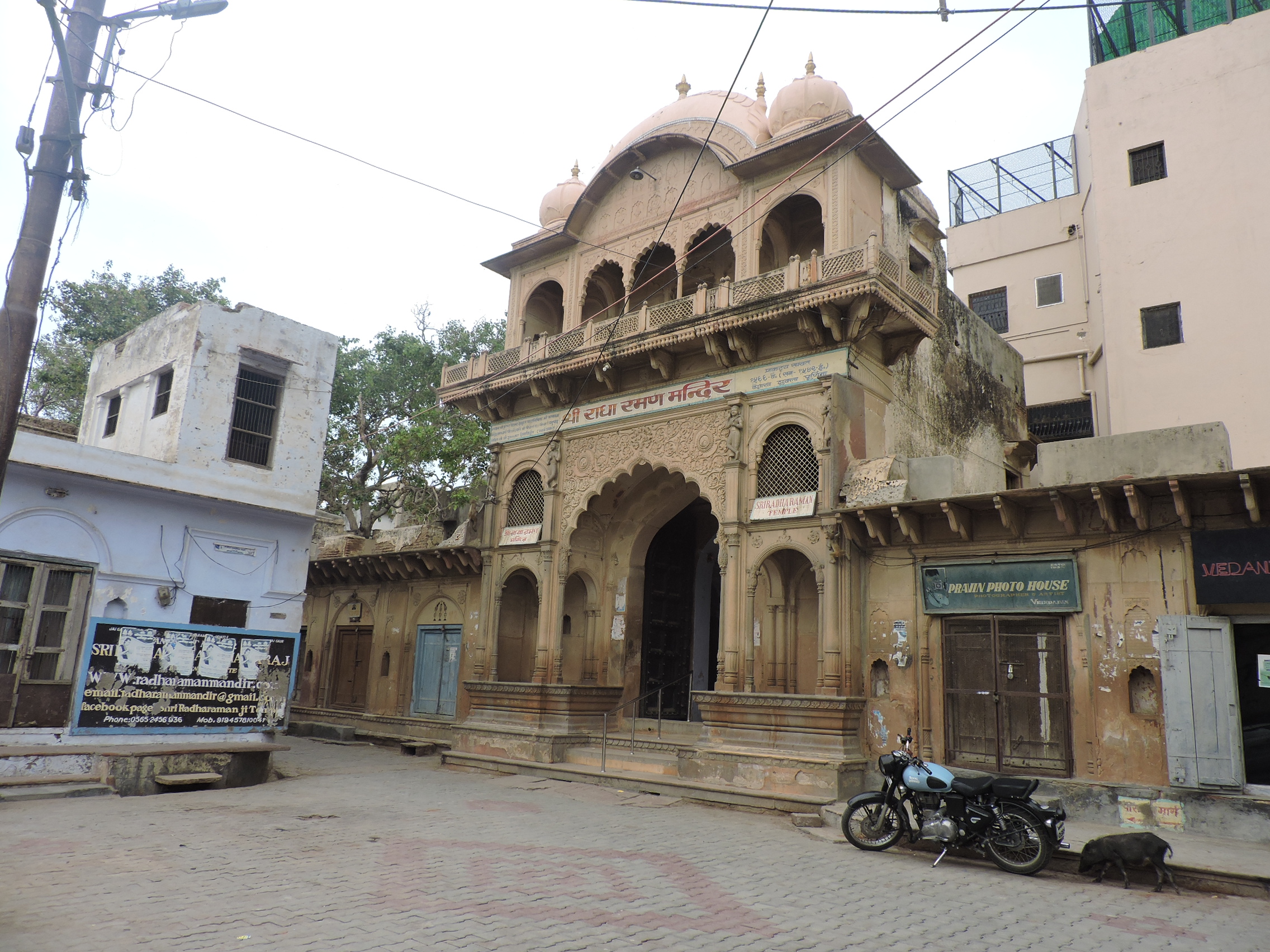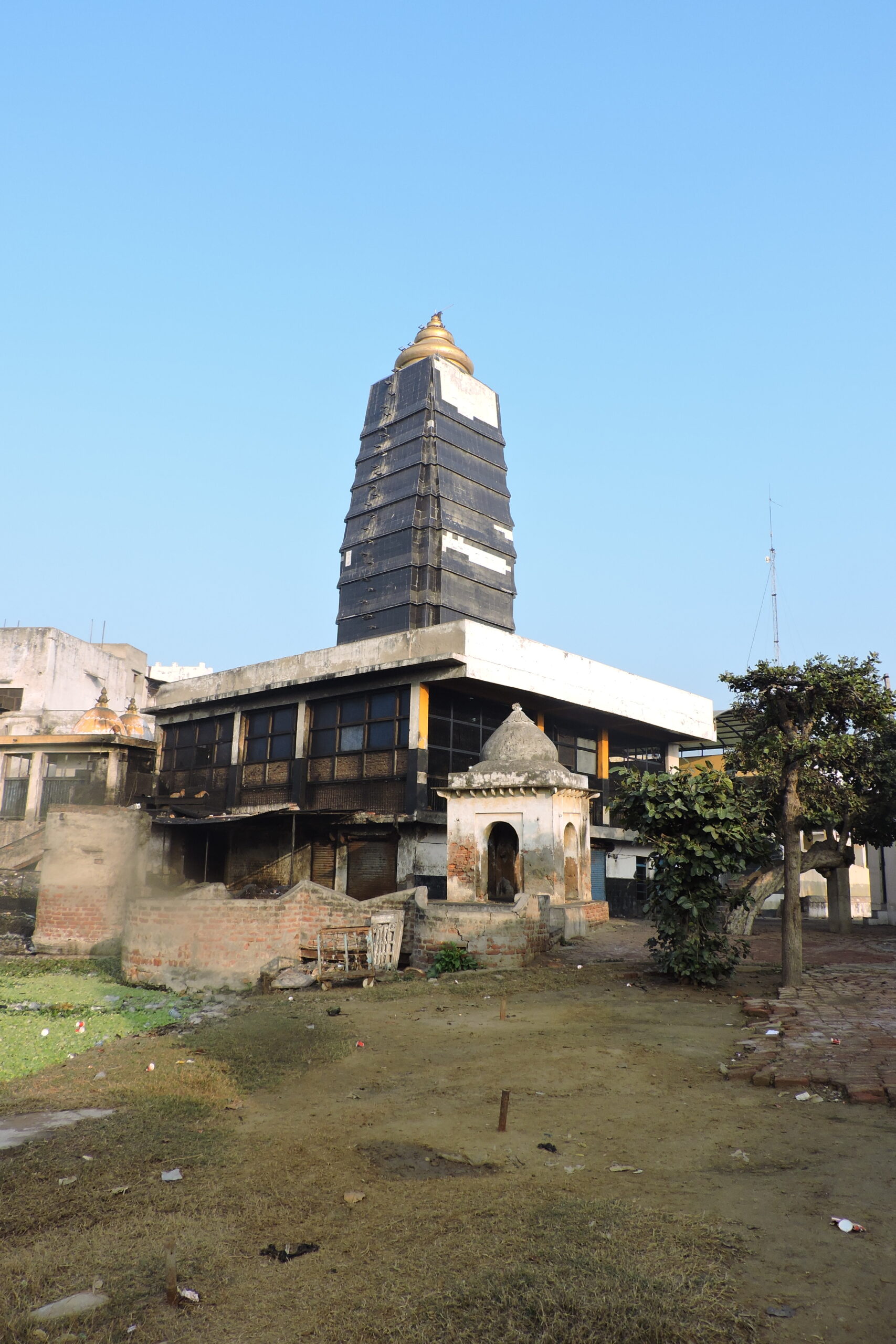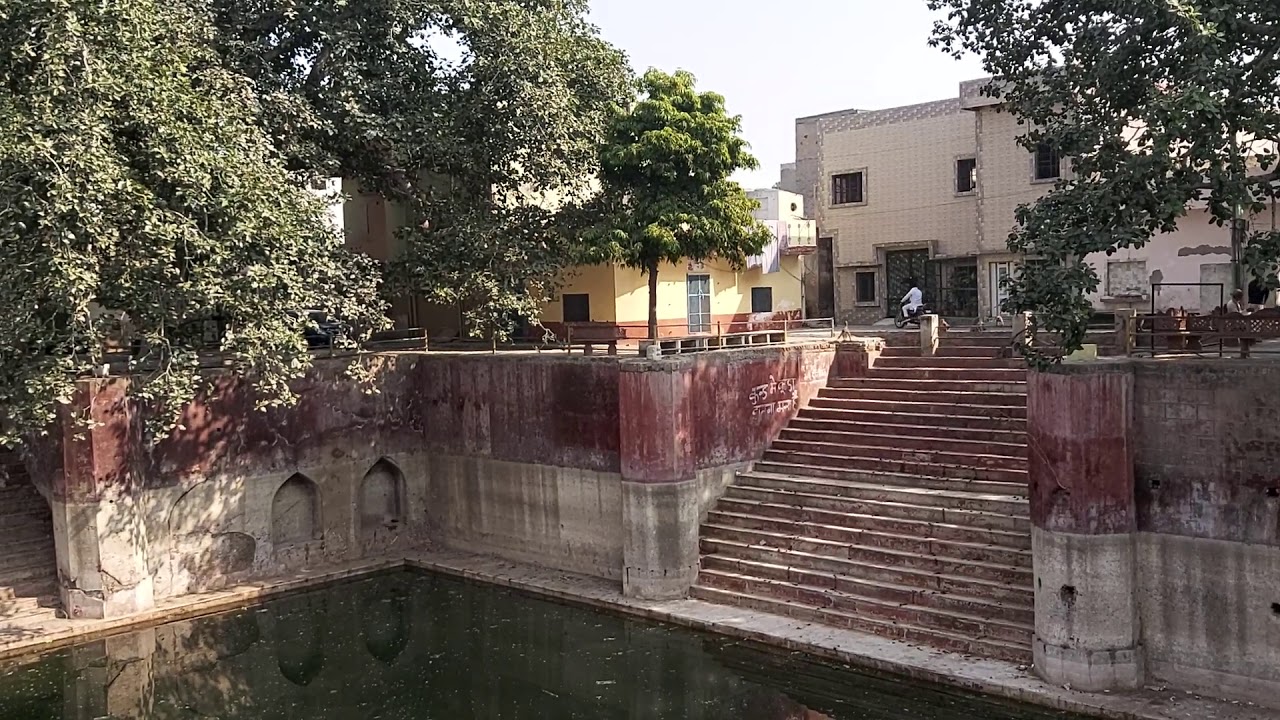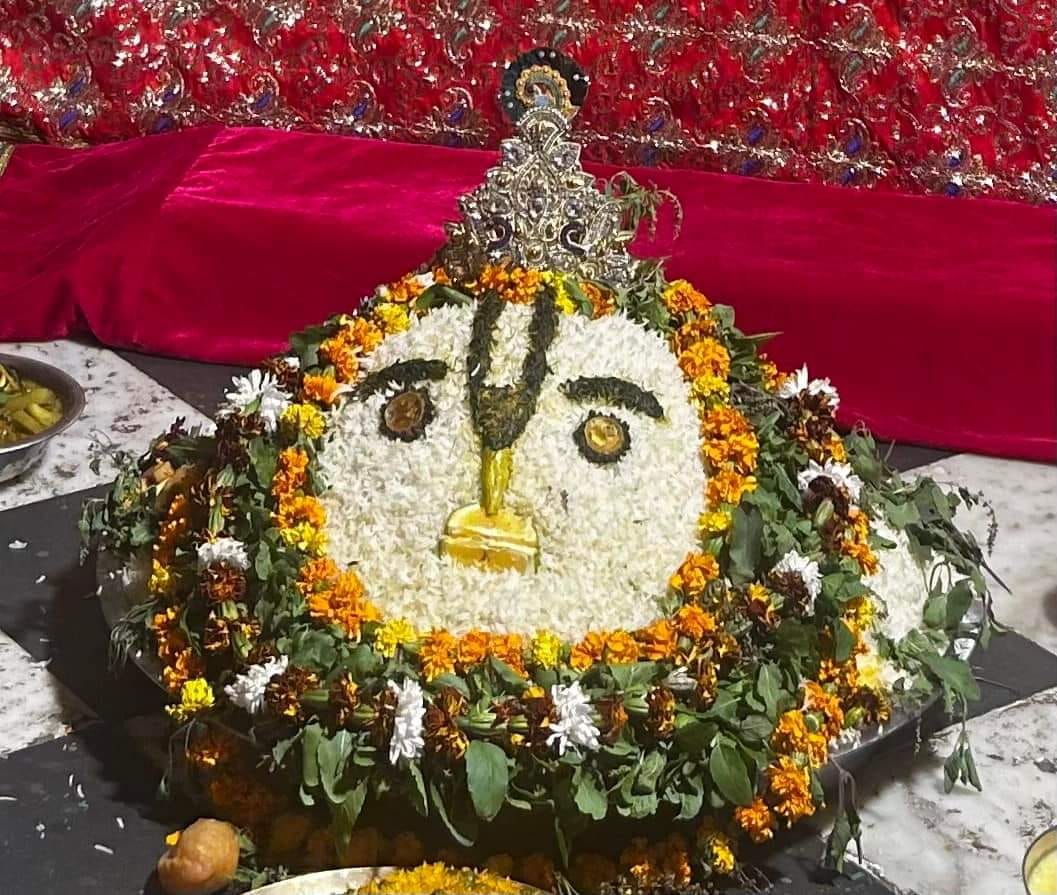2021.10.19 (Vrindavan Today News): Radharaman temple, one of Vrindavan’s historical ‘Sapta Devalaya’ temples, is located just outside the Northern wall of Nidhivan. The temple was founded by Gopala Bhatta Goswami, one of Lord Chaitanya’s six empowered disciples.
Shri Gopala Bhatta and his family were residents of Shri Rangakshetra (near Tiruchirapalli in Tamil Nadu, South India). During his visit to South India, Shri Chaitanya Mahaprabhu stayed at the Bhatta residence (which is still intact). He brought Gopala Bhatta and his exalted family members into the Gaudiya Vaishnava sampradaya and instructed them on the methods of worshiping God in the most intimate form, as Radha-Krishna.
Shri Gopala Bhatta later left for Vrindavan and, once here, he became Gopala Bhatta Goswami. In Chaitanya Charitamrita, Gopala Bhatta Goswami has been described as the 47th branch of Lord Chaitanya’s disciple tree.
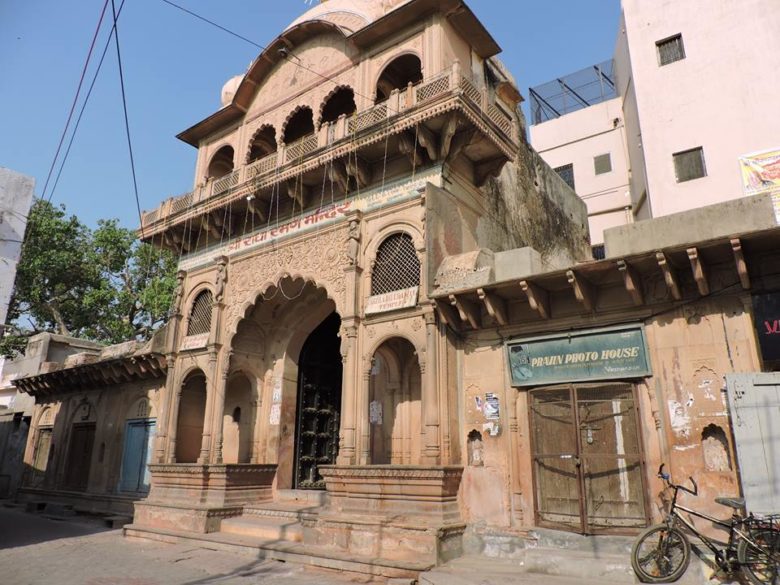
Shri Gopala Bhatta Goswami was always engaged in discourses about bhakti with Rupa and Sanatana Goswami.
Shri Gopal Bhatta began worshiping a sacred Shaligram Shila that he had brought from Nepal while on pilgrimage. However venerable the Shila, Goswami longed to worship the Lord in His Deity form. Goswamiji used to think wistfully that, if he had a Deity, he would be able to dress Him with decorative garments and ornaments.
One day in 1542 A.D., the Shaligram Shila, which is understood to be non-different from Shri Krishna, fulfilled Goswamiji’s desire by appearing in the form of Radharamanji who is Krishna – Lord of Shri Radha. Gopal Bhatta Goswami was pleased to render all sorts of loving service to his Deity, such as bathing, dressing, decorating, massaging, offering foodstuffs, etc.
Radharamanji’s Shalagram form can still be seen on His back. Devotees sometimes get a chance to have Darshan of the Shaligram Shila form on Thakurji’s back when Radharamanji is brought out for abhishek on His appearance day (on Vaishaka Purnima). More than twenty five gallons of milk are used in the bathing ritual.
Almost 5,000 years ago, Shri Krishna performed the Rasa Lila with Shri Radha and the gopis. In the midst of that festival of bliss, he disappeared and took Radha away alone. But, even in that secret exchange of love, Krishna disappeared yet again, leaving Radha weeping in separation.
Almost 500 years ago, in the exact same spot where Krishna disappeared from Radha’s sight, he returned, in the form of Radharamanji.
The three ancient deities of Vrindavan – Govind, Gopinath and Madanmohan – were made by Shri Krishna’s grandson Vajranabh. Govind Dev’s beautiful, rounded lotus face is known as the perfect representation of Shri Krishna’s face. Gopinath’s wide and handsome chest is just like Shri Krishna’s chest, and Madan Mohan’s soft and graceful feet are just like His lotus feet.
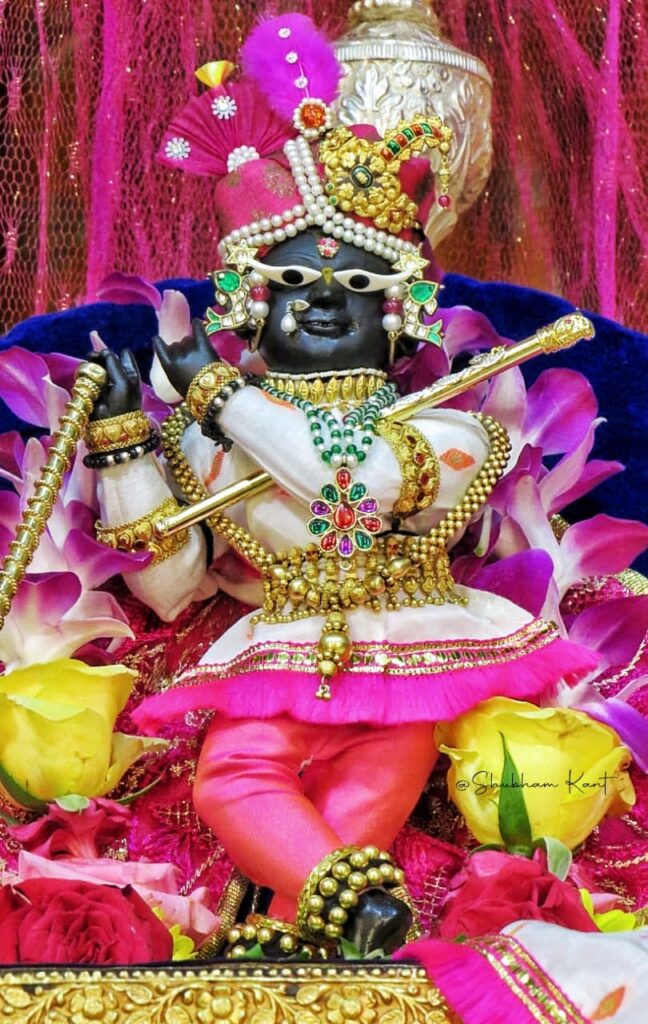
But Radharamanji has the lotus face of Govind, the chest of Gopinath and the lotus feet of Madan Mohan. In other words, he is the exact Form of Shri Krishna. Some devotees consider their Darshan of Shri Krishna complete if they see Govind, Gopinath and Madan Mohan in one day. But when devotees have Darshan of Radharamanji, they feel completely soothed and satisfied.
Temple Festivals
Radharamanji temple celebrates festivals in style. The biggest celebration of the year is held on Radharamanji’s Appearance Day, which falls in May and is accompanied by a week of special events, including cultural performances, kirtan, a Shobha Yatra procession and a Maha-Abhishek for four hours (8am to 12pm).
The temple also celebrates Shri Gopala Bhatta’s disappearance anniversary (Shravana Krishna 4-6) with great pomp and ceremony.
The temple holds frequent cultural programs, in which artists are given the opportunity to perform in front of Shri Radharaman Lal, so, even normal days seem like festival days as guest performers make their song or dance offerings and the occasional visitors mix in with the group of regular temple goers, many of whom spend almost every evening in the temple.
The various festivals of the Hindu calendar are celebrated with great enthusiasm. Dussehra is a particularly special day in this temple, as, on this day Shriji sits on a huge silver elephant. Radharamanji also has a silver jhula to sit on during the Hariyaliteej swing festival in the rainy season. Maha-abhishek of the Deity is done on Janmashtami as well as Radharamanji’s appearance day, and Holi is played in the temple, with the colour fest beginning from Basant Panchami.
The temple
Lord Radharaman is not more than twelve inches height, yet He is very, very beautiful and to have his Darshan is a great blessing. There is no Deity of Radharani in the temple, but on Radharaman’s left is a reverentially placed representation of Shri Radha.
Once, Shri Gopala Bhatta Goswami brought Shri Chaitanya’s kaupina (loin cloth) from Jagannatha Puri. The cloth is still kept within the temple compound and is displayed on special occasions. Other Shalagram Shilas previously worshiped by Shri Gopala Bhatta are kept in Gopal Bhatta’s Samadhi temple, behind the main temple.
The current temple building was completed in 1826 by Shah Kundan Lal and his elder brother Shah Phundan Lal who also built the Shahji temple near the entrance to Nidhivan.
An excerpt from: Seeing Krishna, Margaret H. Case
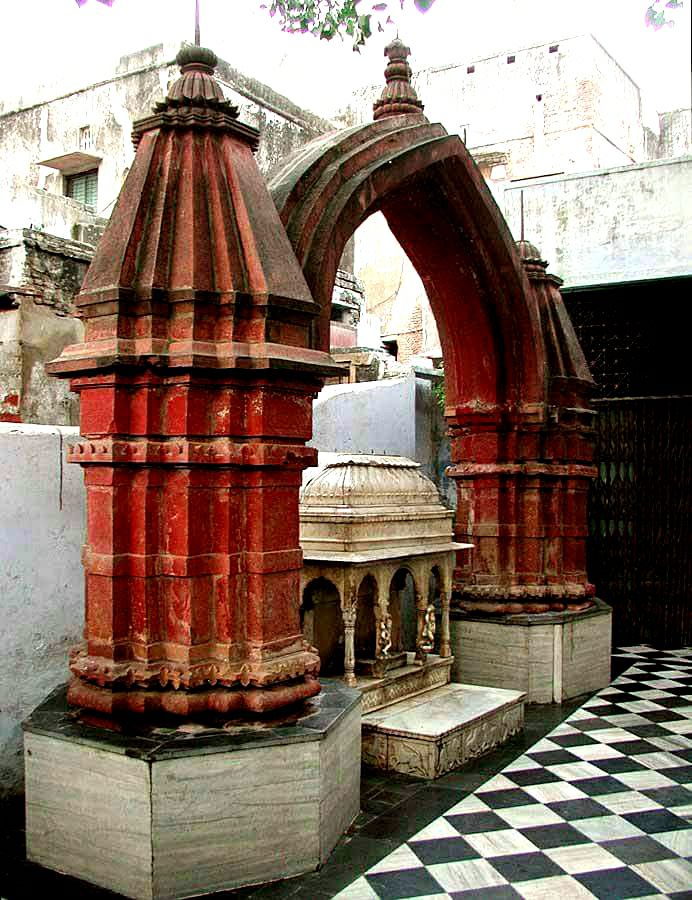
Unlike many deities, Radharaman has never left the temple that is his home. And it is built to look like a home. Many of the shrines of Vrindavan, in fact, are integral parts of the family houses; they are platforms built along one side of a courtyard whose other three sides hold the family’s living quarters, or the living quarters are built above and behind the deity’s shrine. Seen from the outside, Radharaman might seem to be just another of these household shrines. It is nestled at the back of a compound, Radharaman Ghera, which one enters from the street through a massive doorway with heavy wooden doors that are closed at night. The compound courtyard is lined with the houses of Goswamis.
To the left, just inside the gate, is a small passageway that gives access to a red sandstone archway and a shrine marking the spot where Radharaman revealed himself. A tree next to the archway is identified as the very tree in which the basket of shalagramas hung. Next door, there is a memorial shrine of Gopala Bhatta and all the deceased Goswamis.
If one walks straight across the courtyard from the gate, without turning into the passageway with the memorial shrine, one can then turn left, go through another massive doorway with heavy wooden doors, and enter another courtyard lined with more houses.
Now one is facing Radharaman temple itself, a simple sandstone structure at first glance hardly distinguishable from the houses around it. Behind it, still out of sight to the visitor and accessible by a narrow passageway behind the temple, is the small building originally built for Radharaman in the late sixteenth century. This was supplemented after some time by a somewhat larger one built next to it. Both are very plain, small buildings, now used as the kitchen, dining room, and bedroom for the deity.
Because of this discretion in building design and the small size of the image, which could easily be hidden, Radharaman never had to be removed during the political disorders of the seventeenth century, when larger images of the deity left Vrindavan for the safety of Rajput territory; Govindadeva, Gopinatha, Vinodilala, and Radha Damodara, for example, are still in Jaipur.
Even when the doors to the inner sanctum are closed, and the deity is not visible, a few devotees are usually to be found sitting in the porticos or standing around in the courtyard, perhaps chatting with one another.
In the rear (east) portico, facing the sanctum, a singer sits in the morning and evening with a harmonium, perhaps with a tabla (drum) player or with other devotees who keep time with hand cymbals as he sings chants of praise to Krishna.
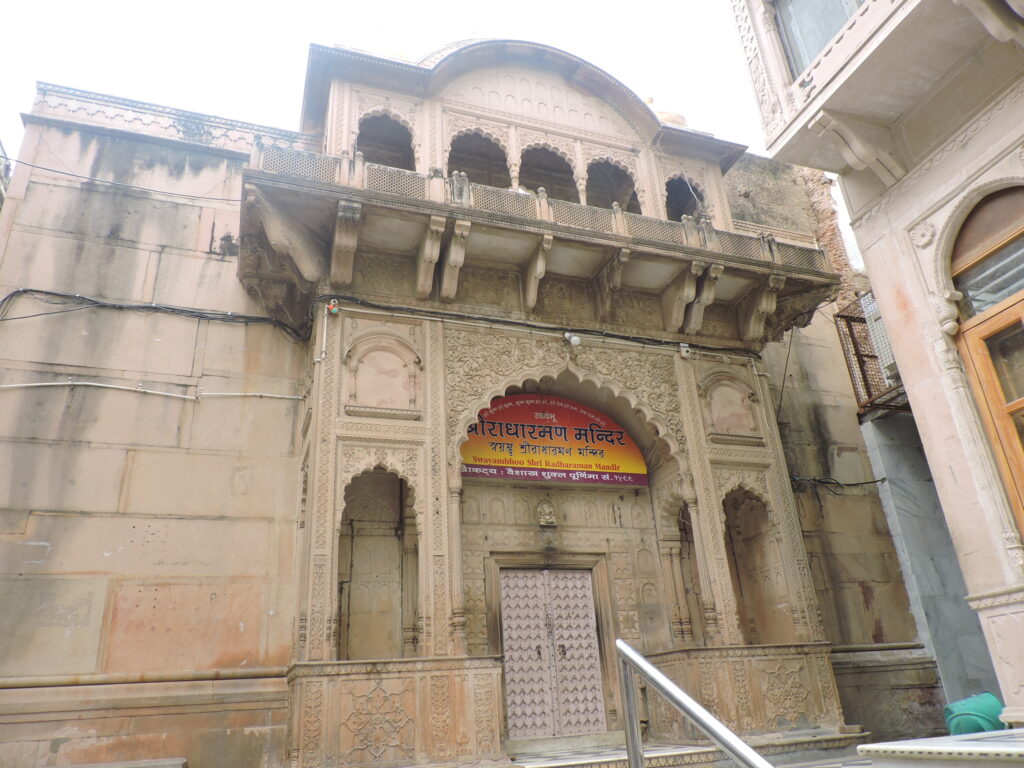
The raised platform that serves as the antechamber to the inner sanctum also has three cusped arches, these of unpainted sandstone; at the rear is an embossed silver double-leaved door leading to the sanctum.
There the deity stands facing east. For about a century, two sets of stairs led from the courtyard up to the platform, and worshipers could go up for close darshan of the deity. When the Temple Entry Act was passed by the British, requiring that temples be open to all Hindus regardless of caste, the stairs were removed, and now only Goswamis and temple servants go up to the platform. In the hot weather and on certain festival days, the deity is brought out to the platform so as to allow his devotees closer access to him.
Seva of Radharaman involves service to the deity throughout the day by priests who are mindful of his eternal, daily activities, which are considered to take place at specific times during the eight periods or watches into which the day is divided.
Only initiates who have touched the feet of Radharaman can prepare the unfried food. All Radharaman’s food is cooked on a fire that has been kept burning since the time of Gopala Bhatta in a ten-foot-long fire pit in the old temple behind the present one, and this fire is also used to light the flames that are offered in arati and the coals that are placed in a brazier in front of his throne on the coldest mornings and evenings.


